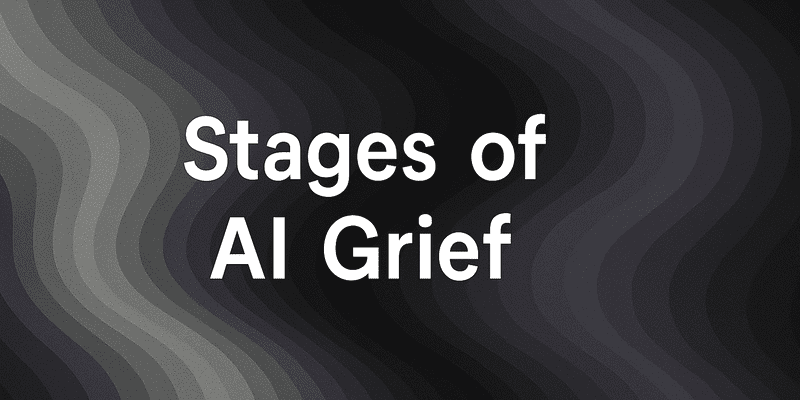The 5 Stages of AI Grief: How to Journey Through the Coming Disruption
-
By Tim King , Executive Editor at Solutions Review
- Best Practices,

We’ve long been told that technology is a tool—something we design, implement, and wield to solve problems. For decades, that’s largely held true. But with the rise of generative AI, large language models, and machine-driven decision-making, many seasoned tech professionals are facing a far more unsettling reality: the tool is now reshaping the craftsman.
This is not a routine wave of innovation. It’s a seismic shift in the professional ecosystem—one that doesn’t just touch the tools we use, but the roles we hold, the authority we’ve earned, and the very value we bring to the table. For many, this transformation is deeply personal. The rise of AI feels less like a new opportunity and more like a slow erasure of everything that once defined their career.
And the response? It’s not just strategic. It’s emotional.
From Grief to Growth: Now Is the Time to Act
Like any form of disruption that challenges our identity and sense of security, the AI revolution is prompting a psychological reckoning. What many tech leaders are experiencing—whether they recognize it or not—is grief. Grief over a disappearing professional landscape. Grief over a loss of mastery. Grief over the evaporation of clear paths to relevance and respect.
This article walks through the five classic stages of grief—denial, anger, bargaining, depression, and acceptance—but reframed for the modern tech leader watching their role bend and blur under the weight of AI adoption. It’s not meant to alarm. It’s meant to validate. To name the emotions. To acknowledge that yes, this is happening—and it’s okay to feel disoriented.
But most importantly, this journey doesn’t end with loss. It ends with clarity and action.
Empathetic AI adoption and human-centered readiness are no longer nice-to-haves. They’re survival tools—for companies and individuals alike. This piece is your invitation to pivot, not panic. To begin thinking—seriously—about how to adapt, upskill, and build support structures in a reality where machines don’t just assist you… they compete with you.
Let’s begin where every journey of transformation starts: not with strategy, but with honesty.
Denial — “AI Can’t Do What I Do”
Denial doesn’t always look like ignorance. Sometimes it wears a suit and tie, speaks confidently in meetings, and quotes past disruption cycles with pride. For experienced tech leaders, denial is often a defense mechanism built not out of apathy, but out of legacy. You’ve navigated change before—cloud migrations, DevOps transformations, cybersecurity overhauls, mobile-first revolutions. Each time, the headlines screamed “paradigm shift,” and each time you found your footing and added value. Why should AI be any different?
The first wave of generative AI tools—chatbots, code assistants, synthetic media engines—felt like toys, or perhaps tools better suited for junior staff or marketing. They were interesting, even clever, but clearly lacked the depth, precision, and domain awareness required to operate at your level. They couldn’t reason through legacy system entanglements. They couldn’t manage vendor relationships. They certainly couldn’t navigate enterprise risk frameworks or design multi-cloud infrastructure strategies.
And so, the mind settles into a comforting story: “AI can’t do what I do.” It feels rational. It feels earned. But it’s incomplete.
Because what AI can’t do today, it is rapidly being trained to do tomorrow—not by magic, but by feeding on the very operational documentation, meeting notes, system logs, and institutional processes that once served as the moat around your expertise. The model isn’t guessing—it’s learning, by consuming the digital residue of your life’s work.
And yet, even as AI closes the gap, denial lingers. Not because the data isn’t clear, but because acknowledging it threatens too much. It threatens your sense of control. It threatens the unspoken contract that experience guarantees relevance. It threatens the deeply held belief that human insight is always indispensable.
This stage isn’t foolish. It’s human. Denial gives us time to breathe before we confront what scares us. But it’s also a trap. Because while you’re in denial, others are re-skilling. Others are redefining their value. Others are quietly leapfrogging you—not because they’re smarter, but because they’re facing reality faster.
The sooner you recognize denial for what it is—a temporary shield—the sooner you can begin the work of realignment. And in this new AI-defined world, timing isn’t just a competitive edge. It’s a survival skill.
Stage 2: Anger — “How Dare They Replace Me?”
Once denial begins to crack, it doesn’t give way to quiet acceptance—it gives way to rage. And not without reason.
You’ve given your career to this industry. Late nights, firefights, failed rollouts turned recoveries, budget battles, impossible deadlines met with grit and caffeine. You’ve kept businesses running through outages, pivoted during pandemics, and built the digital scaffolding that now supports entire enterprise ecosystems. You’ve made decisions that no machine could have made—decisions that balanced nuance, risk, people, and profit.
So when someone—often much younger, often armed with a shiny deck and very little historical context—starts talking about “streamlining operations” or “automating cognitive workflows,” you don’t just hear innovation. You hear replacement. You hear redundancy. You hear erasure.
And it stings.
The anger comes fast and hot. At the C-suite for chasing efficiency at the expense of human capital. At the vendors for selling AI tools as miracle cures without explaining the human cost. At colleagues for embracing these systems with naive enthusiasm. At the industry itself for changing the rules without warning. But perhaps most sharply, the anger turns inward: Why didn’t I see this coming? Why didn’t I prepare sooner?
This is the most volatile stage. Some lash out, criticizing every AI initiative or sabotaging pilots behind closed doors. Others go quiet, disengaged, passive-aggressive, hoping the hype will pass. But the reality is, this stage isn’t about logic—it’s about betrayal. AI feels like the ultimate act of professional disloyalty: a cold, statistical replacement for the messy, intuitive, deeply human labor that built the enterprise to begin with.
It’s tempting to stay here—to become the skeptic in the back of the room, the contrarian voice who always finds the flaw in the model. But anger is corrosive. It consumes your energy without returning clarity. It shuts down your openness to learning. And worst of all, it isolates you at the exact moment when connection and collaboration are most needed.
Feel the anger. Acknowledge it. But don’t feed it.
Because what comes next is an opportunity—not just to survive AI, but to renegotiate your role in a way that aligns with what makes you uniquely human. But to get there, you’ll need to trade outrage for strategy.
Stage 3: Bargaining — “Maybe If I Just Learn Prompt Engineering…”
By now, the denial has faded and the anger has exhausted itself. What remains is a restless, scrambling urge to regain control—to find some lever, some skill, some angle that will make this all feel survivable again. This is the stage where the mind turns entrepreneurial, but with a hint of desperation: “Maybe if I just…”
Maybe if I take that machine learning certification.
Maybe if I become the company’s AI ethics champion.
Maybe if I volunteer for the GenAI pilot team.
Maybe if I write a whitepaper on AI policy and post it on LinkedIn.
Maybe if I call it augmentation instead of automation, I’ll feel better about it.
This is bargaining.
It can look productive—and often is. Bargaining tends to awaken initiative, drive, and creative problem-solving. You start signing up for webinars, testing out GPT-based tools, poking at use cases you can bring to the leadership team. You shift your internal monologue from fear to positioning: “How can I make AI work for me instead of against me?”
But there’s a subtle trap here: in many cases, what you’re bargaining for isn’t transformation—it’s preservation. You’re not really redesigning your value; you’re trying to repackage your old value with a new vocabulary, hoping that will be enough to weather the storm. This mindset can lead to surface-level adaptation—learning to craft clever prompts or using AI to speed up your reports—without addressing the deeper need to rethink your role entirely.
It’s also where many get stuck. They mistake motion for progress. They focus on tools instead of trajectory. They learn to use AI in tactical ways while quietly hoping it won’t demand anything more foundational of them. But the truth is, it will.
Bargaining is a healthy impulse—it means you haven’t given up. But it has to mature into something more sustainable. The goal isn’t just to stay in the room—it’s to stay relevant in the room. That requires not just adding AI to your skill set, but asking harder questions: What do I bring to the table that machines can’t? Where is the new demand for human leadership, empathy, and trust emerging in this AI-first landscape?
The answers to those questions won’t be found in a prompt engineering crash course. They’re found in a deeper reimagining of your identity, your leadership, and your future value.
And if you’re brave enough to go there, you’ll emerge from this stage not with a crutch—but with a compass.
Stage 4: Depression — “Maybe I Don’t Belong Anymore”
This stage doesn’t always announce itself with tears or dramatic exits. More often, it arrives silently—through fatigue, detachment, or a slow erosion of confidence. You show up to meetings, but speak less. You browse new job postings, but nothing fits. You watch demos of AI-driven systems that replicate 80% of your core responsibilities and feel a pit form in your stomach. You smile when someone calls you “legacy talent,” but inside, it lands like a eulogy.
This is the moment when it becomes painfully clear: the professional terrain you mastered has shifted beneath your feet. The old playbooks are being rewritten by algorithms. The new vocabulary of success is forming without your input. And the certainty you once held—that you had a role, a place, a future—is dissolving into ambiguity.
The hardest part of this stage isn’t the fear of being replaced. It’s the feeling of being forgotten.
You begin to wonder if your experience is now a liability. If the decades you spent becoming an expert in one domain now make you too slow to pivot. You look at the bright-eyed AI evangelists—many of whom lack the scars and hard-won lessons you carry—and wonder if the future really has a place for leaders like you. You don’t say it out loud, but you feel it: Maybe I don’t belong anymore.
It’s not just career grief. It’s identity grief.
This is the stage where many begin to withdraw. They stop raising their hand for new initiatives. They ghost their networks. They quietly opt out of innovation councils or AI roundtables. Not because they don’t care—but because participation feels like self-exposure. Like confirmation that the game has changed, and they’ve fallen behind.
If this is where you are right now, know this: you are not alone.
This is not weakness. This is the natural pain that comes with mourning the loss of professional certainty and relevance in a world moving faster than ever. But here’s what matters most: depression is not the end of the story. It is the clearing. The moment before rebirth.
The silence of this stage creates space—for reflection, reinvention, and, ultimately, renewal. But it requires honesty. You must allow yourself to grieve what’s been lost. Only then can you start building something new—not just with skills, but with vision.
There is a future for you in the AI age. But it won’t be a continuation of the past. It will be something forged with humility, courage, and a willingness to reimagine what value really means.
And on the other side of that reckoning is something precious: clarity.
Stage 5: Acceptance — “It’s Time to Pivot”
Acceptance isn’t surrender. It’s not rolling over and letting the machines win. It’s not bowing out quietly or romanticizing a career that “had a good run.” Acceptance is a conscious decision to face reality with your eyes open—and to move forward, not in fear, but in wisdom.
This is the stage where the fog lifts.
You see, perhaps for the first time, that AI isn’t just here to disrupt your job—it’s here to redraw the map of work itself. Roles are being redefined. Skills are being reshuffled. Entire categories of expertise are being compressed into a few keystrokes. And yet, in the midst of this churn, something vital becomes visible: there are things AI cannot replace.
It cannot lead with empathy.
It cannot coach a team through uncertainty.
It cannot discern the emotional nuance in a boardroom conflict.
It cannot earn trust, inspire change, or carry the moral burden of decision-making.
It cannot care.
These are not soft skills—they are irreplaceable human competencies. And you begin to realize: this is where your new value lies.
Acceptance means letting go of your old identity without losing your purpose. You stop trying to be the expert on everything and start becoming the integrator, the interpreter, the conscience in the room. You move from technician to translator—connecting the logic of the machine to the lived experience of the business and the people it serves.
You start building a new framework for relevance—not based on proprietary knowledge or gatekeeping, but on adaptability, emotional intelligence, and ethical judgment. You seek out training not just in tools, but in leadership. You align with communities that are grappling with the same transformation. You reach out, instead of retreating.
You begin to see AI not as your competitor, but as your context.
That’s the pivot. Not away from your career—but into a wiser, more human-centered version of it.
And yes, acceptance may come with grief. You may still feel the sting when someone automates a task you once mastered. You may still feel moments of nostalgia for when your expertise was the final word. But those feelings no longer paralyze you. They become part of your story—not the end of it.
This is your moment to evolve—not in reaction to fear, but in alignment with truth.
You are not obsolete.
You are being redefined.
Final Thoughts
If you’ve recognized yourself in any of these stages—whether you’re still in denial or already embracing reinvention—you’re not alone. This journey isn’t just yours. It’s unfolding quietly (and sometimes not so quietly) in boardrooms, data centers, Zoom calls, and late-night searches across the entire professional landscape.
But here’s the difference between those who merely endure this shift and those who emerge from it with renewed purpose: those who act.
This is not the time to wait and see. This is the time to move—with clarity, with community, and with courage. Because the organizations that will thrive in the age of AI are not just the ones with the best models or the fastest automations. They are the ones who understand the human cost of transformation—and prepare for it with empathy.
That’s where you come in.
Now is the time to:
-
Invest in human-centered upskilling: Not just technical credentials, but the interpersonal, strategic, and leadership capabilities that AI cannot replicate.
-
Seek professional support networks: Isolation is the enemy of transformation. Join communities of others navigating this same shift. Share stories. Exchange strategies. Normalize uncertainty.
-
Advocate for empathetic AI adoption: Push for policies and practices that prioritize transparency, workforce transition planning, and ethical guardrails—not just efficiency.
-
Redefine your value with intention: You are more than your technical skill set. You are a mentor, a leader, a builder of culture and resilience. Own that. Expand it.
This moment in history is not just about adapting to technology. It’s about reclaiming what it means to be professionally human in an age of intelligent machines.
And that begins when you stop grieving the past—and start building what’s next.
Let’s get to work.
This article was written by Tim King on July 17, 2025
Tim King
Executive Editor
Tim is Solutions Review's Executive Editor and leads coverage on data management and analytics. A 2017 and 2018 Most Influential Business Journalist and 2021 "Who's Who" in Data Management, Tim is a recognized industry thought leader and changemaker. Story? Reach him via email at tking@solutionsreview dot com.
- The Best LightsOnData Data Governance Training and Online Courses for 2026 - December 8, 2025
- Storage and Data Protection News for the Week of December 5; Updates from Atlas Storage, Quantum, Rubrik & More - December 5, 2025
- Data Management News for the Week of December 5; Updates from Cloud Software Group, Prophecy, Snowflake & More - December 5, 2025



